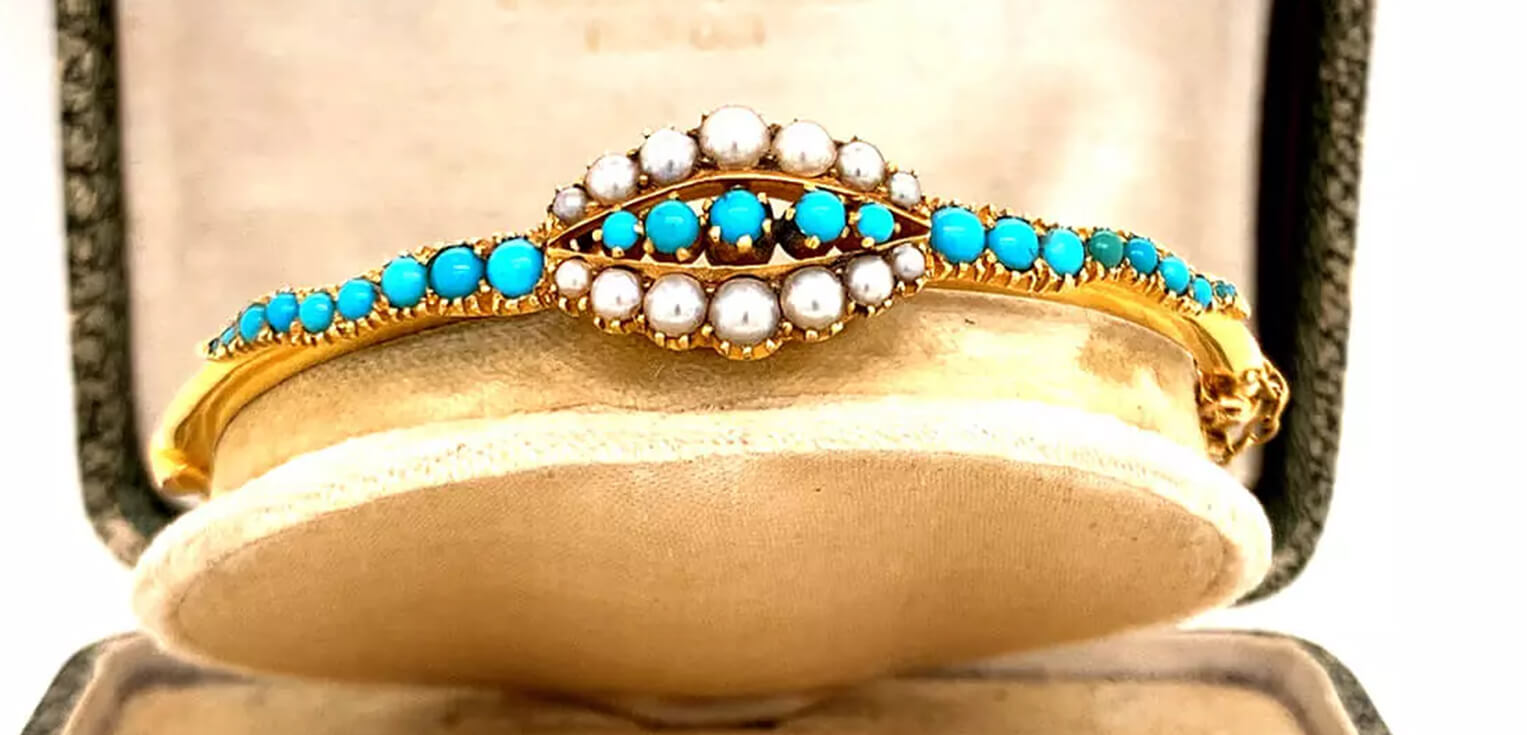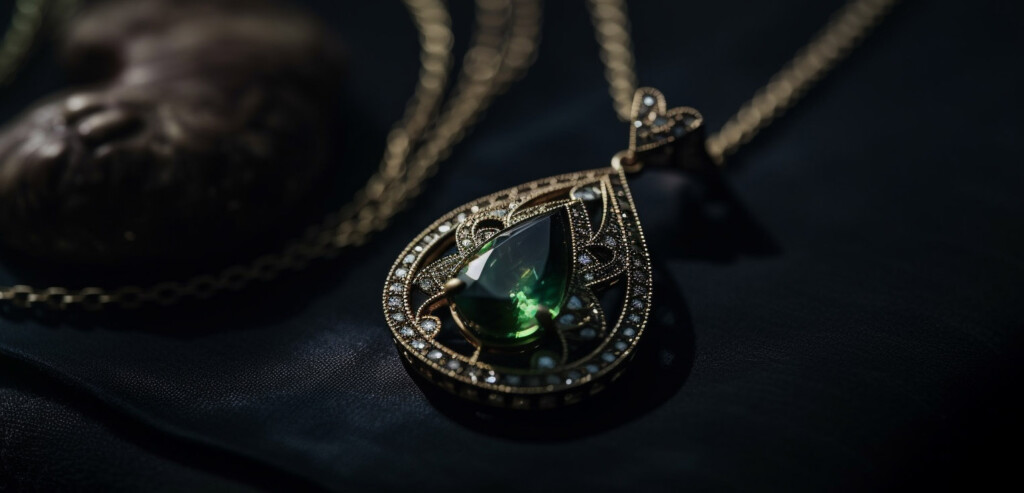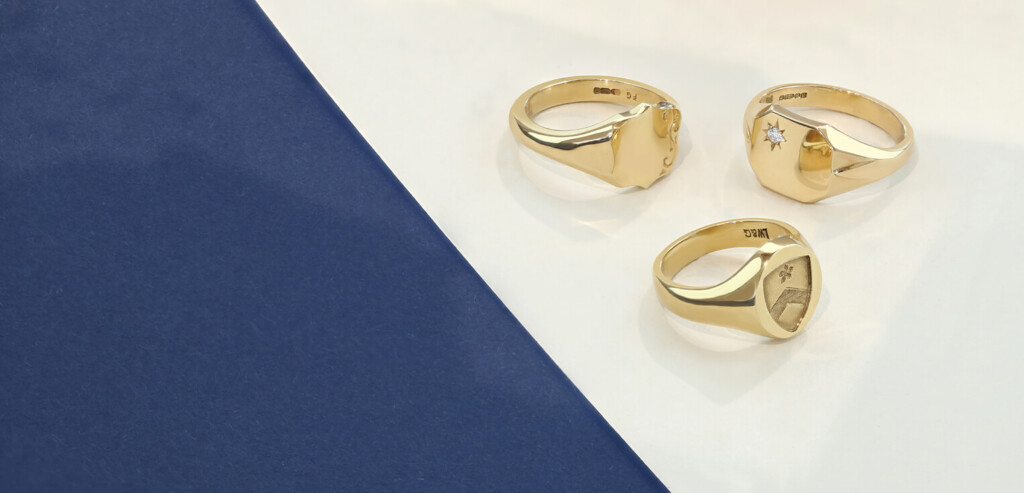Turquoise is a brilliantly blue gemstone that is instantly recognisable with its distinct and unique veining in various shades from bright whites to deep green. A bold yet timeless stone, turquoise makes the perfect addition to your jewellery collection.
In this article, we will look at the history of turquoise and how and where it is formed, as well as the deeply symbolic meanings turquoise has to many cultures, past and present. We will also give you our top tips and tricks on how to wear and care for your turquoise jewellery, to ensure that you can enjoy your new jewels for many years to come.
How is Turquoise formed?
This unique, brightly-colored stone is formed when water that contains copper or aluminium leaks through a rock. The veins created by this mineral-rich water slowly turn into turquoise over many years, and the web-like pattern created in the turquoise is dependent on what material the ‘host rock’ is.
This means every turquoise has its own unique pattern, making for beautifully bespoke gemstones everytime. This natural ‘matrix’ pattern and bright blue colour makes it very hard to mimic successfully, so it’s quite easy to spot fake turquoise. If a stone looks too uniformly bright blue, you may want to check that it’s real. Embracing the naturally occurring variations and patterns are part of the charm of real turquoise.
Turquoise is very porous, so in order to improve its longevity, commercial turquoise often goes through a process to stabilize it. Historically, beeswax was used to fill the pores in the turquoise gemstone, although more modern practice involves injecting a colourless resin into the turquoise. This process improves the strength and hardiness of turquoise used in jewellery, making it suitable for everyday wear.
Symbolism and meanings of turquoise
Though it takes a long time to form, turquoise gemstones have been around since around 3000 BCE. There is evidence of turquoise being used in many different cultures, as far back as the Ancient Egyptians and in Aztec, Navajo and Mayan cultures, too.
With its bold blue colour, this sacred stone has strong ties to nature, namely to the sky and water. In Egypt, turquoise is associated with the goddess of the sky, Hathor. Throughout history, turquoise has been used in ceremonies and rituals, said to represent heaven and help passing to the afterlife, often adorning burial tombs and even the burial mask of Tutankhamum!
A powerful talisman, turquoise is deeply symbolic to many cultures, often known as a healing stone that promotes peace and tranquility for its wearer. Calming and soothing, turquoise gemstone jewellery can help you to stabilise energy and emotions, perfect to ground feelings of anxiety.
Turquoise is also the birthstone of December and of the star sign Saggitarius , making a piece of turquoise jewellery the ideal gift for your December-born friends or family members.
How is turquoise sourced?
Turquoise has been found all across the world, from China (this largest producer) to Mexico.
Unfortunately, many turquoise mines have been closed down over the past few decades. This is down to a multitude of reasons, from the rising costs of mining, increased government regulations to improve safety of miners and the sheer popularity of turquoise leading to over-mining.
This means that turquoise jewellery is becoming even more rare and precious, making it a great, timeless investment piece, and a staple in any jewellery collection.
We recommend looking for antique or vintage pieces. Not only is this a sustainable and stylish solution, it’ll also ensure you have a unique, statement jewellery item that no-one else will have.
Shop vintage and antique turquoise jewellery
How to wear turquoise jewellery
Due to its vibrant nature, turquoise sits beautifully in both cool and warm toned metals, so you can choose from silver, white or yellow gold settings for your jewellery. That means you can choose jewellery that suits your style and existing jewellery collection.
As turquoise is a softer stone, avoid wearing jewellery directly next to your turquoise pieces to avoid scuffing or scratching. Instead, make a statement with your turquoise jewellery and wear it alone.
Turquoise is a versatile gemstone that can be worn with casual or formal outfits. Paired with simple, classic outfits like a crisp white shirt and jeans can make a statement and stand out, or worn with a sophisticated little black dress for formal occasions can add a striking pop of colour.
With turquoise long-standing popularity across the world, there are lots of different styles that turquoise gemstones suit. From graphic Aztec designs, to 1920s ‘Egyptomania’ inspired art deco pieces, turquoise adds a bright element to a plethora of designs, and is a timeless jewellery addition to your collection.
Taking care of your turquoise jewellery
On the Mohs hardness scale, it sits at around 5 or 6 out of 10, making it slightly harder than window glass. While this means it is easier to cut and carve into intricate shapes and jewellery designs, in gemstone terms, turquoise isn’t as hardy as diamond, for example.
That means it is perfect for earrings or pendants, though you might want to be a little bit careful when it comes to rings or bracelets, as turquoise can suffer from scratches or knocks.
Though it is ok to wear your turquoise jewellery every day, it’s important to take proper care of your jewellery in order to keep it strong and shining.
We recommend avoiding getting your turquoise jewellery wet, taking it off when washing your hands, showering or swimming. If your turquoise jewellery does get wet, don’t worry. Just aim to dry it off as soon as possible.
As with all jewellery, we recommend taking it off before bed and storing it out of direct sunlight. Avoid getting any harsh chemicals or perfumes on your jewellery, as this can cause discolouration or deterioration over time.
Final Thoughts
With its vivid, vibrant colour and rich sacred symbolism, turquoise is a gemstone that is steeped in history and meaning. Formed over millions of years, turquoise is a timeless choice to add to your jewellery collection in a statement or subtle way.





